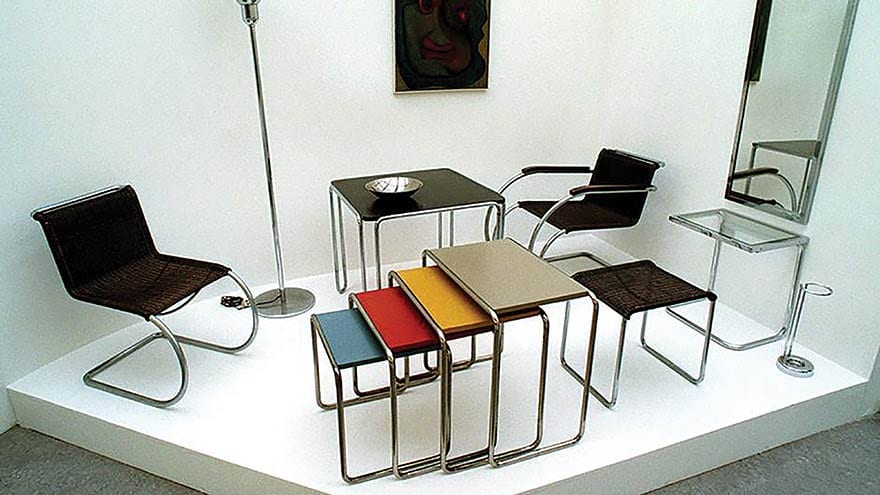The legendary ‘Staatliches Bauhaus’ school of art and design (1919- 1933) celebrates the centenary of its establishment this year, and its impact is universal despite the fact that it was only operational for 14 years. The Bauhaus was a hub for all innovations in the fields of fine art, applied art, design and architecture, and its impact was felt, and can still be felt, in all of those fields.
The Bauhaus concept – reduced form, simplicity and functionality – influenced all creations – from the designs of book covers to home lighting, furniture, interior decoration etc. The Bauhaus legacy was replaced by postmodernism and other styles, but it is now trendy again around the world.

It was back in 1919 that then young architect Walter Gropius described the period of despair in Germany following the end of World War I as a catastrophe of world history. His response was a bold but surprisingly pragmatic Utopian vision – Bauhaus. With the establishing of this new kind of art school, he succeeded in creating a wonder of culture with the influence that continues to spread to this day.
The Bauhaus, as the new school of applied arts and architecture in the city of Weimar, was founded with the idea of combining arts and crafts, but it proved truly revolutionary in the fusing of art and industry. Gropius wrote in his manifesto: “Architects, sculptors, painters, we must all return to crafts!”

ARCHITECTURE DESIGN
From the outset, the Bauhaus proved very interesting as an art school, an academy ready to remain part of real-life rather than turning into a haughty academic institution. The Board of Trustees, which consisted of Gropius’s friends, soon expanded to also include Albert Einstein, while the lecturers included the leading fine artists of the time, such as Josef Albers, Lyonel Feininger, Wassily Kandinsky, Paul Klee, Oskar Schlemmer and Ludwig Mies van der Rohe – the third director of the Bauhaus, who would go on to become one of the legends of the history of architecture.
Distinguished individuals and intellectuals, the creative people that the Bauhaus brought together ensured that teaching there would be extremely unconventional. The Bauhaus thus became much more complex and contradictory than the entertainment studio where works of art emerged spontaneously – as it was described at the time by some individuals. And that isn’t to say that fun was lacking.
On the contrary, Bauhaus parties were frequent and part of the schooling process itself, serving to further the idea of ensuring a connection between artists and the wider community. “Tell me how you have fun and I’ll tell you who you are,” said artist Oskar Schlemmer.
In his manifesto, Bauhaus founder Walter Gropius wrote: “Architects, sculptors, painters, we must all return to crafts!”
For Walter Gropius, building houses was “the ultimate goal of all design activities”. As a result, students of his school didn’t only learn theory and practise in school workshops – he also sent them to construction sites, in order for them to put into practice what they’d learned about form, colours and materials. The most important principle was: form follows function.

“Design isn’t just what you see and feel. The design also relates to how something functions.” This might sound like a slogan of the Bauhaus school, but it’s actually a quote of the founder of Apple. Specifically, Steve Jobs strictly adhered to the belief that form should follow function, and that is completely obvious in the world of design and technology to which he belonged.
Respecting this principle, students of this art school developed numerous applied art objects, such as furniture or everyday items. In this work, it was important to have clean and cold elegance, instead of the playfulness of artistic lines. Many of the prototypes from those workshops were launched in mass production, but only a small number succeeded in achieving Gropius’s second aim: a price for everyone’s pocket.

Among the most successful examples are certainly the wallpaper produced by the Rasch wallpaper factory in Hanover or the famous black desk lamp designed for company Kandem. Given that many copied it, many were eventually also able to buy it.
The Bauhaus School has become best known for the sketched designs of its architects. In many cities, residential buildings constructed on the basis of these ideas had the primary goal of solving the problem of a lack of living space.
Gropius wanted to solve urbanism problems by

building large apartment buildings with many apartments.
Examples of this endeavour are represented by housing estates in Dessau or Berlin. Many new residences were admittedly created in this way, but this simultaneously also led to the anonymity of housing, which later resulted in new social problems. But they were no longer in the focus of the builders of the Bauhaus.
It was in 1925 that the school had to leave Weimar and move to Dessau, because the new conservative government of the state of Thüringen, where Weimar is located, began causing problems for the revolutionary Gropius and his associates. Gropius himself designed the building of the new school, where professors and students relocated in 1926. The building, with its workshops with glass facades, became the manifestation of the concept of modern architecture.
The Board of Trustees also included Albert Einstein, while lecturers included Josef Albers, Lyonel Feininger, Wassily Kandinsky, Paul Klee, Oskar Schlemmer and Ludwig Mies van der Rohe
Over the years, four “Master’s Houses” were built in Dessau, which included apartments and study rooms for teachers, while a residential estate with a total of 60 buildings emerged later. It was five years later that the administration of the Bauhaus school was taken over by architect Ludwig Mies van der Rohe, but quickly after that (in 1932) the school was shut down by local leaders of the National Socialists.

Although the Nazis themselves also emphasised functionality when constructing industrial facilities, they considered the Bauhaus movement suspicious and eventually declared it “Jewish” and “Bolshevik”. The school then relocated briefly to Berlin but was closed for good after the Nazis took power in 1933. Many of the professors abandoned Germany. Although the school was gone, its teaching remained very influential – and still is to this day.
The Bauhaus didn’t teach architecture during the first half of the school’s existence, but the influence of the Bauhaus is today mentioned the most precisely when it comes to the design of residential buildings. Many today refer to the Israeli city of Tel Aviv as a true “Bauhaus City”, although not one of its designers was actually a student of this school.

The entire region around Weimar and Dessau, where the Bauhaus tradition is still cultivated, is today known as BauhausLand. In a region where rich historical tradition has been fused successfully with modernism, there are as many as nine buildings listed under UNESCO protection, which is extremely rare worldwide. The famous Bauhaus Party is held here every year, and this year’s Weimar Summer Arts Festival was also dedicated to the Bauhaus, with the idea of this movement “returning home”.
There’s no doubt that Gropius would like the advertising slogan used today by a department store chain for interior and exterior home decoration: “Bauhaus – Yes, it would be good!”